Some Ulysses III Themes for Marked
Let’s keep playing around with Ulysses III, shall we? I rather enjoy writing in it, and I like seeing the finished, formatted version of my work in Marked. I created some custom themes for Marked to match Ulysses’ color schemes (available for download at the bottom of this post). First, though, a few words on using Marked with Ulysses.
Here’s how The Soulmen answer “Is there a Markdown preview?” in their FAQ:
In External Sources, you can directly preview Markdown files. Right-click on a sheet and open it in your favorite Markdown processor. We can recommend Brett Terpstra’s wonderful Marked app for this.
As I said in my review, external sources don’t really offer you the full Ulysses experience. The product page is careful to mention that Marked is only supported with external sources, since they’re just loose documents on your hard drive; they would work with Marked no matter what. However, I can be less cautious: only external sources fully support Marked preview.
Full Marked support, by my measure, means the document will update live while you’re editing it. At present Marked does not support opening the raw text document at the core of your Ulysses sheet, so live updating is out.1 You can, however, export the current sheet directly to Marked, where it will be formatted like any other Markdown document. You won’t be able to live update as you type, but you can manually push your edits to Marked.
All you have to do is access the quick export popover in the top right-hand corner of Ulysses. When you click it, select the text tab, then make sure you Markdown selected as your format. Hover over the “Open In…” button so a down-arrow appears just to the right of it. A list of available editors will pop down. Choose Marked.
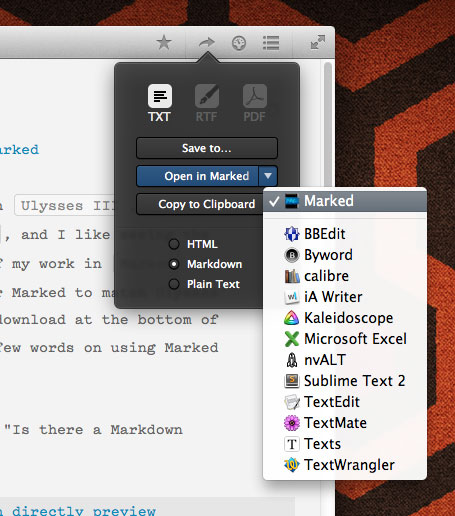
Ulysses Quick Export
Marked will open up your current sheet. Doing the same thing again will push any new edits to the document in Marked. The “Open In…” button will retain the previous app you used for quick export, which in my case will almost always be Marked. Now I can expedite pushing changes to Marked by hitting ⌘6 to bring up the quick export popover. If the middle button is highlighted blue and says “Open in Marked” all I have to do is hit return and it will push the changes. If not I can use directional arrows to move to the correct button.
This works on glued sheets as well. You can also highlight a bunch of sheets and do a quick export; Marked will see them as one long document, just as you see them in Ulysses.
In practice I rarely use live updating in Marked anymore. I only use it to read through longer pieces in a proportional typeface, to get myself in a proofreading mood. I’d like to see live Marked support come in a future update, but I’m perfectly happy knowing I can get to it from the keyboard in two clicks.
Now about those themes. My personal favorite is the Freestraction theme that ships with Ulysses. It’s easy on the eyes in both light and dark modes, so I decided to copy it for two custom Marked themes. Here they are:
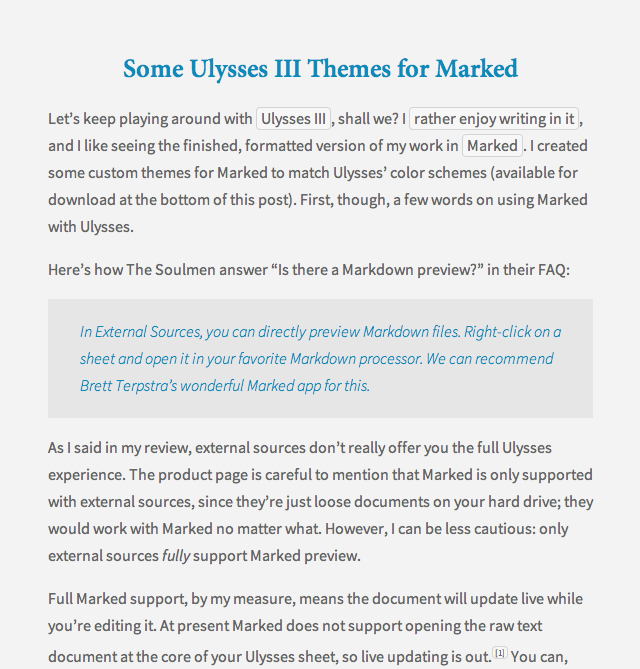
Ulysses Freestraction Light
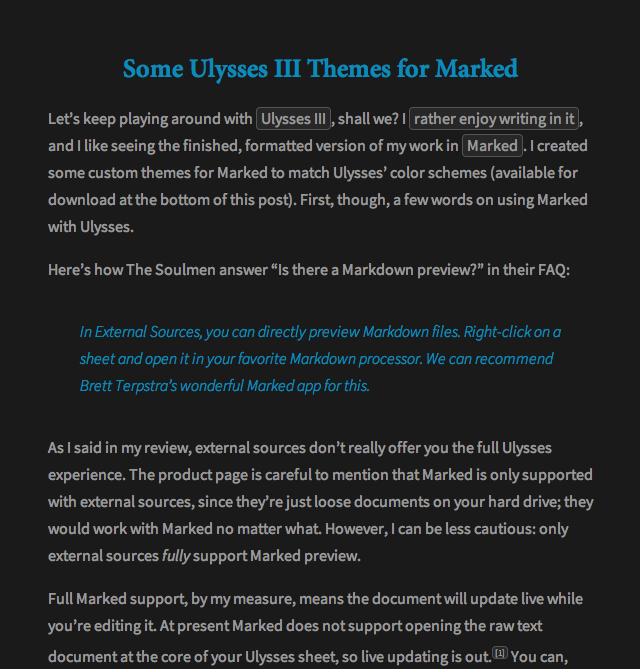
Ulysses Freestraction Dark
Download Ulysses Themes for Marked
The following installation instructions are lifted right off of the Marked product page (at the very bottom):
- Save the CSS file to a safe place such as ~/Library/Application Support/Marked/Custom CSS
- In Marked Preferences, go to the Styles pane
- Use the plus button to add a new style, locate your CSS file and hit “OK”
- Your style will be named based on the name of the CSS file, and will now be available in the Style dropdown menus
Happy writing.
Further Reading:
-
I can tell you that I actually have gotten live preview working but it’s difficult to get going, potentially corruptive and, as Max from The Soulmen would probably yell at me, it’s UNSUPPORTED. ↩︎
Add (Mostly) Universal Search to Ulysses III with an Alfred 2 Workflow
As I mentioned in my review, universal search is not currently implemented in Ulysses III. I’ve got an Alfred Workflow that picks up the slack on that front until The Soulmen ship an update. It allows for full text, sheet and group name search. Here’s what it looks like:

Ulysses Search in Alfred
Type uly and your query, then pick your group or sheet and it will open in Ulysses. Easy peasy.
Note that this will only search sheets and groups stored in iCloud or On My Mac. Daedalus documents are stored as text documents with a hash for a title, so the results look (in a word) crazy.1 External documents are external; deal with them externally.
**Bonus:** This Alfred workflow adds a File Action for opening Text and RTF documents in Ulysses. When triggered, it will import the document to your Inbox, and even convert the rich text to Markdown for you. Neato.
Download Search Ulysses 3.alfredworkflow
-
Worse: if you were to open a text document in Ulysses, it wouldn’t take you to what you’re looking for, just import the document again to your Inbox. ↩︎
Mac App Review: Ulysses III
In college I bought a copy of James Joyce’s Ulysses. This stately, plump tome, to be exact. I didn’t read it. I tried to, sure, but after a few weeks it became clear I needed to move on.
Every few years I start reading it again from the beginning, each time making it a bit further than my last attempt; never very far. Up until this latest release, The Soulmen’s text editor that shares a title with Joyce’s novel was only too aptly named for me. It never clicked. That’s all changed with Ulysses III.
Getting Organized
I’ve written before about how most editors get in my way. In praising Drafts, I wrote this:
Nearly every app I use on iOS utilizes the same basic “document” model. Whatever I write usually needs a name and/or tags so that it can be differentiated from the other documents. As such, I couldn’t open an app and start writing without feeling like I was working on something.
The more writing feels like work, like a chore to me, the less I feel like doing it. On iOS, Drafts solved this problem. On the Mac, the closest thing to an app that allows me to just aimlessly write has been nvALT. I use and love nvALT, but for notes, little snippets of information I may need access to later. I never launch it just to write.
Ulysses III puts writing front and center, doing away with the “document” model. Instead, you compose text in “sheets” which can be organized into “groups” (basically folders). A sheet doesn’t need a title, though you can add one with a Markdown header. There is an Inbox where you can compose loose bits of text for later organization or just get to writing.
All of this gets stored in the Ulysses database, which has its advantages. For one, you don’t need to clutter up your file system with snippets of text. By keeping your writing in Ulysses, you can add attachments to sheets, including photos, notes and keywords (or tags). These items follow your sheet no matter where you file it.
Filters allow you to create a search folder, similar to a smart mailbox in Mail. You can search the full text of documents in your entire Ulysses database, or limit the search to a single group by, say, keyword or modification date.
I’m using filters right now. I’ve got a few sheets for different sections of this review. Some sheets have the keyword @first-draft attached to them, some have @second-draft and some both. I’ve got filters limited to my Ulysses Review group for each keyword, so I can view each draft separately. By doing this, I’m able to edit the same sheet in both drafts, which jibes with my brain more than making multiple copies of the same text.
Ulysses III also makes the best use of OS X’s Versions feature I’ve seen in an organized writing app. Hitting ⌘S in any sheet will save a version of it in its current state. This again obviates making multiple copies of the same sheet, allowing you to simply go into the Versions browser to see previous edits. This is the first implementation of Versions I’ve actually wanted to use.
Editing Text
Out of the box Ulysses ships with syntax highlighting for John Gruber’s original Markdown, an extended syntax they’re calling Markdown XL1 and Textile2. From there you can create your own syntaxes and set up your own highlighting color schemes and keyboard shortcuts.
Most of the highlighting is pretty basic (*italics* are italic, **bolds** are bold), but some elements become invisible. Link text, for example, is displayed with a colorful halo around it with the URL embedded, accessible in a popover. You can create a link by surrounding text with square brackets or with the keyboard shortcut ⌘L.
Ulysses III is stunning to look at. It’s not distraction-free-douchy, but it definitely gets out of your way to let you focus on writing. Have a look at it:
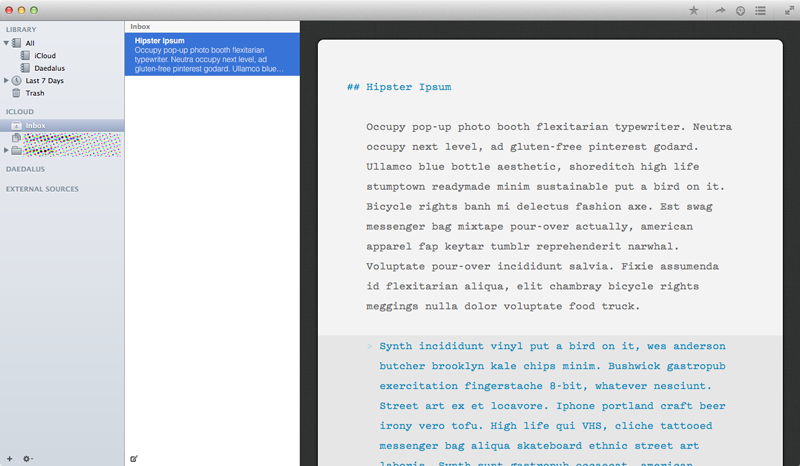
Ulysses 3 Screenshot
Ulysses 2 looks comparatively:
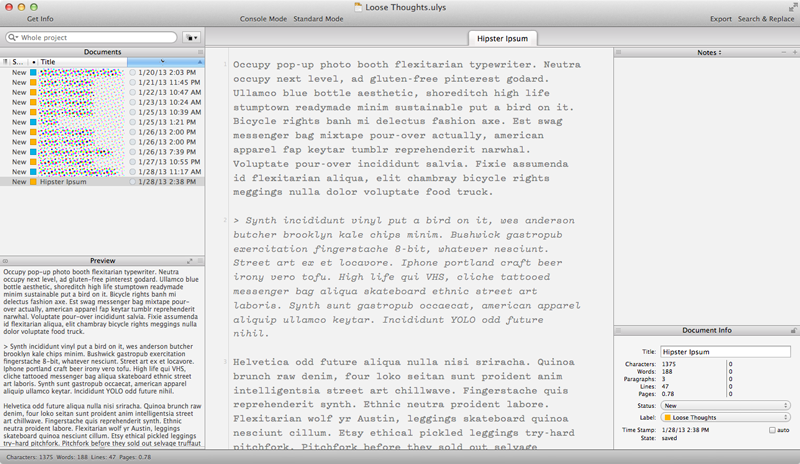
Ulysses 2 Screenshot
Each of the two panes on the left side of Ulysses III can be folded underneath the editor window, allowing you to only focus on the document at hand. It’s simple and delightful to watch the app animate into place, which you can quickly invoke with ⌘1 (all panes), ⌘2 (Editor and current group) and ⌘3 (Editor only). In each view, the app will grow from the center out as opposed to treating the sidebar panes as drawers. This feels logical, though it’s the first use of such an animation I’ve seen in any Mac app.
The Kitchen Sync
Where Ulysses III really wins me over is its sync implementation. The app offers three sync options: iCloud, Daedalus and External Sources. There is also an On My Mac mode which keeps documents on your Mac, un-synced, though I’ve turned this off for the time being. Each comes with its own set of caveats. Let me try to lay them out simply:
- iCloud: Mac-to-Mac syncing. Makes full use of the features described above as it syncs the entire Ulysses database.
- Documents have to live in the Ulysses database, meaning they are not editable by other applications until you export them.
- Identical to On My Mac, except items are synced.
- Daedalus: Mac-to-iOS syncing (via iCloud) for use with Daedalus Touch.
- No support for custom syntaxes, only straight Markdown.
- No support for nested groups, attachments or filters (this makes some sense if you’re familiar with Daedalus’ interface).
- External Sources: Allows you to read and write documents from anywhere on your system, like your Dropbox folder.
- No support for custom syntaxes, groups, filters or attachments.
- Will only parse Markdown text for documents with the extension
.md;.txtdocuments need to be converted to.mdto allow for syntax highlighting.3
If you prefer a Dropbox text editor on iOS like iA Writer, Byword or Elements, then you can use the external sources mode to edit your documents in Ulysses. However, this is the most stripped down experience you can have in Ulysses III. I think it’s a nice feature if you don’t use Daedalus Touch, but I think users trying to fit Ulysses into their workflow with it will end up being disappointed.
The sync with Daedalus Touch is phenomenal. I love being able to make edits on any device and have it stay in sync on all of them. In my experience iCloud does a much better job than Dropbox at keeping documents up to date. I can leave Ulysses open, even to the document I’m editing with Daedalus on my iPhone, and the changes will stay consistent, intelligently.
I’ve had varying degrees of success keeping sheet order in sync across devices. Right now if I reorder sheets in a stack on my iPad it will reorder the sheets on my Mac and iPhone, even while I’m looking at them. I’ve had less luck going the other way, though in my testing, like I said, I’m staring at my devices watching paint dry. Even from the last version of the beta I used sync has improved exponentially; I imagine edge case bugs like this will get squashed in future updates.
I’ve turned the On My Mac header off in the sidebar (you can also do away with iCloud and Daedalus, if you please). My thinking here is that I want to keep my documents in sync via iCloud. Technically my documents are still “on my Mac,” just in the Mobile Documents folder. There has been a lot of hubbub about iCloud being a terrible product, but I’m enamored of it for document syncing. I use CrashPlan to constantly back up my Mac, including the Mobile Documents folder, so I feel confident that, should something go awry, I’ll always be able to restore my Ulysses database. And for documents I’m extra worried about, I can always export them.
What’s Missing
Ulysses III is a 1.0 app. Since they wrote a brand new app from the ground up, some aspects of Ulysses 2 are missing. The biggest one you need to know about right now is universal search. You can search for text in a single sheet, but at present there is no way to search your entire database. The workaround right now is to create a filter with, but it’s not a real solution by any means.4 The Soulmen have promised this is coming in the future updates.
There is currently no support for auto-pairing of most characters. While ⌘I will surround your cursor with asterisks, Ulysses doesn’t intelligently pair parentheses or back-ticks. Square brackets, in addition, will create a link popover. If you want to use actual square brackets, you’ll need to escape them with backslashes (\[Like so\]), which is annoying, but in practice I rarely use square brackets outside of links, which Ulysses handles well. You can create TextExpander snippets to trigger auto-pairs, or you can create keyboard shortcuts for elements of custom syntaxes.
Typewriter scrolling and line highlighting didn’t make the cut for 1.0. I’d like to see keyboard shortcuts for the attachments menu, which is currently only accessible with the mouse. This makes sense for images, which have to be dragged into the app, but I’d like quicker access to keywords and notes. And it would be nice if they implemented something similar to TextMate’s Go to File… menu, which allows for quick search without ever taking your hands off the keyboard. These missing items may be deal-breakers for some, but I’m making do without them. What I get in sync-ability and organization more than makes up for it.
Wrapping Up
I use Ulysses III for almost everything I write now. Long-form writing, aimless yammering, quick things I don’t want to forget; it’s all going into Ulysses or Daedalus. It’s solid, beautiful and simple. And it’s only going to get better.
The Soulmen have now completely reinvented themselves. Many established Mac developers have tried to make iOS versions of their biggest apps because users have been clamoring for it. When Daedalus launched in 2011, I noted in my review that they had actually been working on an app called Ulysses Mobile at the time. I applauded their resistance to shipping that product at the time, but I had no idea that Daedalus would in turn influence Ulysses.
Ulysses is still on sale for $19.99 during their launch week event, but soon it will go up to $39.99. Go grab it5 and get back to writing.
Other Apps Mentioned in this Article
Purchasing any of the apps mentioned with the links below supports the candler blog. I thank you in advance:
-
Which mainly add extended attachments and footnotes. ↩︎
-
And that’s the last time you’ll hear me talk about Textile. Since I’m a Markdown writer, as far as I’m concerned Ulysses is a Markdown editor. ↩︎
-
Gabe Weatherhead explains this best in his review. Be sure to check out the comments where Max from The Soulmen responds to him. ↩︎
-
I’ve also got another workaround I’ll be publishing soon. ↩︎
-
Affiliate link. ↩︎
Goodbye, Roger
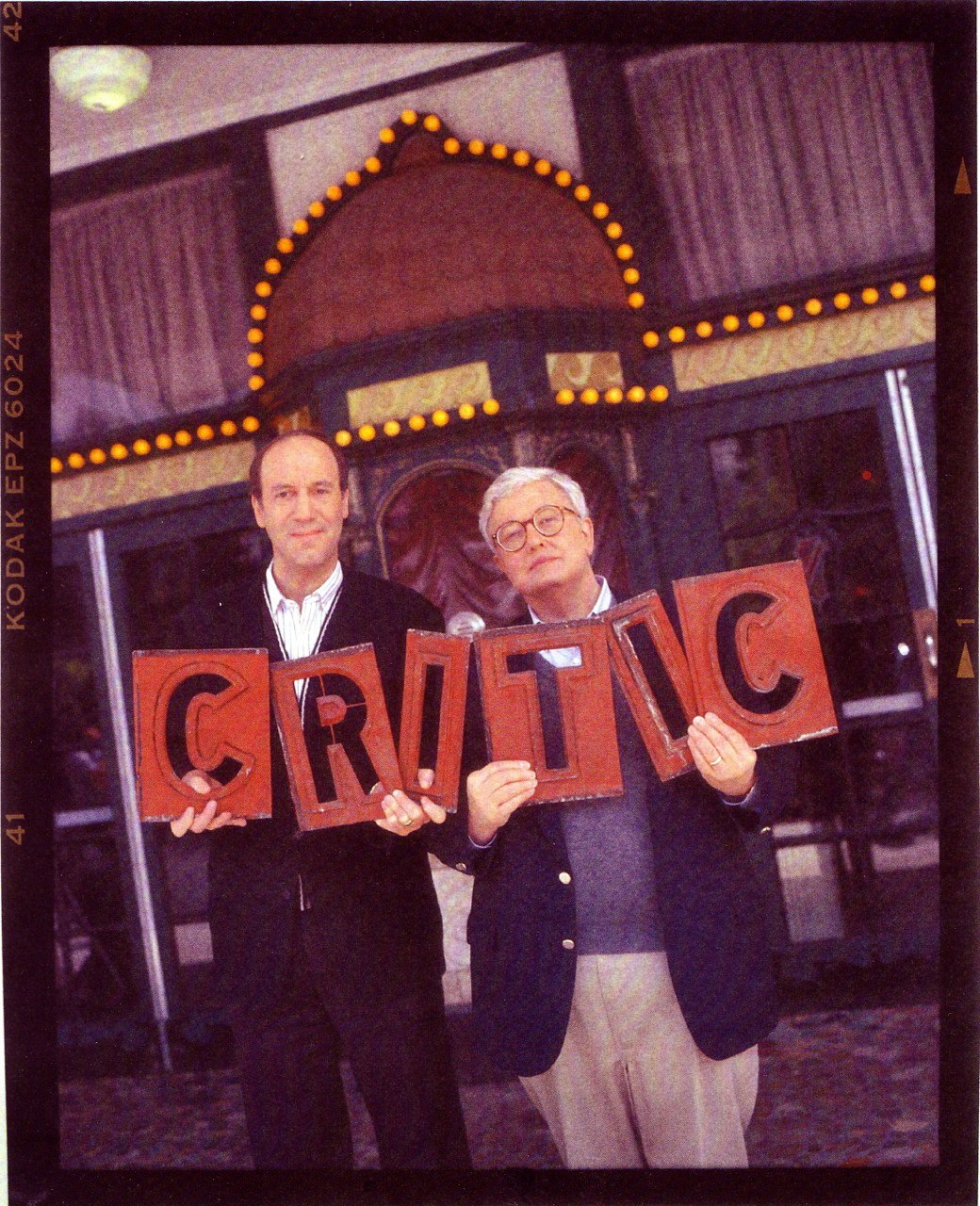
Gene Siskel and Roger Ebert
Sad news: Roger Ebert has passed away.
Writing on the Web had no greater champion than Ebert. He was encouraging, generous and humble. He didn’t care about the masthead under which your writing appeared. He would share anything he came across and enjoyed. He took joy in using his celebrity to shine light on the work of others and make film criticism an ever-expanding field.
I was once the recipient of his generosity. On January 22, 2012, Roger posted two links to the candler blog on Twitter and Facebook. As if that weren’t enough of a gesture, he very kindly said some nice things about me. After that there was no going back for me; like it or not I was a writer online. Roger said so.
I bring up that experience because I know that he inspired many thousands as he did me. That may even be an understatement.
Besides his little rule book, there is one piece of wisdom of his that is always in my mind. From his foreword to Nicholas Jarecki’s Breaking In: How 20 Film Directors Got Their Start, which I read at a very impressionable age:
It doesn’t matter if you go to film school or not, or which film school, or what you study. It doesn’t matter if you work on film or video, or what kind of camera you use. It doesn’t matter if you write in the morning, or at night, or on yellow pads or on a Macintosh. It doesn’t matter if you work as an intern or an apprentice, in Hollywood or Austin or anywhere else. It doesn’t matter what movies you watched or what books you read—as long as the answer is “a lot of them.” What matters is that you called yourself a movie director, and you made a movie.
Thank you, Roger. Your mark will be felt for generations to come.
Further Reading:
- I heard Roger speak in 2011. As ever, he was an inspiration: “Don’t be the next Roger Ebert, be the first you.”
(photo via Roger’s Facebook page)
Ulysses III [Mac App Store Link] ⇒
The Soulmen just released the excellent Ulysses III text editor. I’ve been using it since January and I love it. Forget what you know about previous versions of Ulysses, this is a ground up rewrite; more accurately a rethinking of what a text editor is.
I’m still putting together a review of it, but I’ll say this much: Ulysses III solves most of my text problem. It’s on sale during launch week for $19.99 (50% off). Go get it.1
-
That’s an affiliate link, as is the headline link of this article. Using it to purchase Ulysses III supports the candler blog. I thank you in advance. ↩︎
Go Listen to Me on Generational ⇒
Gabe Weatherhead was kind enough to have me on his Generational podcast to talk about Fountain, markup languages, apps and whatever else came to mind (which most definitely came out of my mouth). It was great speaking with him and Erik Hess. Go give a listen.
Alfred 2 Workflow to Search DuckDuckGo by Way of Google Suggest
DuckDuckGo via Google Suggest
Here’s a quickie workflow for Alfred 2. David Ferguson, a nerd who works on Alfred, has been building some excellent extensions for the launcher/so-much-more app. His Google Suggest workflow caught my eye, only I don’t particularly like using Google for my Web searches anymore. Luckily it’s easy enough to modify workflows in Alfred 2.
Google’s suggestions are a great feature. I use them all the time in Safari1 even though I’ve set the default search engine for the location bar to DuckDuckGo. I like DuckDuckGo’s commitment to privacy and the simplicity of their bang (!) searches. If I want to search on Google, I just type my string and add “!g” to do so. But they don’t offer a suggestion feature. That’s where David’s workflow (and my modification) comes in. (Download it here.) See update below.
I set the shortcut in Alfred to “s” for “search.” Launch Alfred,2 type “s” and then the start of a search string. Google suggestions will come up, selecting any of them and hitting Enter will take me to DuckDuckGo results. Selecting a result and hitting tab will put the cursor after the selected phrase, allowing me to add whatever bang I please, like !imdb or !a for Amazon.
I’m happy I got an Alfred Power Pack, which unleashes the power of workflows. I’m excited to see what else this little app can do.
Updated May 8, 2014: Changed plugin to support the new (and if you ask me, superior) DuckDuckGo Next. More info here.
Highland is on the Mac App Store ⇒
Highland, the lynchpin of any Fountain workflow, is on the Mac App Store now. John August published an excellent introduction to the app this morning. Comes with a new font, Highland Sans, that looks just gorgeous.
$9.99 until the end of March. Go get it.
Brief Thoughts on a Few Films from SXSW
This has basically been an insane week for movie, tech and media news. I know the candler blog has been quiet of late, but it’s not because I’ve stopped paying attention to things. It feels like every time I sit down to compose a piece something else massive happens that diverts my attention. That and, uh, I just haven’t been setting aside enough time to write.
Anyway, I’d like to play catch up and give you a short update on my goings on at SXSW this year.
This year marks my fourth fest, but my first as a local. As such, I saw way fewer films than I used to. This used to happen back when I lived in New York too: I wouldn’t take off of work for Tribeca and NYFF, so I’d go to as many screenings as I could in the evenings. Now that I live here I had to balance work and SXSW, or at least try. I still saw a nice helping of films though.
By far my favorite new (to these shores) non-headliner film was Good Vibrations, directed by Lisa Barros D’Sa and Glenn Leyburn. It’s a biopic of Terri Hooley, the man who brought Belfast’s punk scene to the rest of the world. Narratively it’s a straghtforward affair, but it nails the feeling of discovering a new and exciting art form. The scene where Terri, played by Richard Dormer, hears local punkers for the first time nearly brought me to tears. It perfectly summed up what it’s like to cross over from ignorance to understanding, from being lost to finding purpose. And the trick is in Dormer’s eyes. It’s truly a performance to behold.
I forewent the opening night The Incredible Burt Wonderstone1 and instead went next door to check out Shane Carruth’s Upstream Color. I still haven’t seen his first feature, Primer, but the Stateside Theater was loaded with fans of the 2004 film. His latest has garnered a lot of support in the indie community, but I found it to be a trial just to get through. Basically Carruth removes anything resembling exposition from the film, a choice that confuses me more than it excites me.
Plus I wasn’t a fan of the way the film looked. Upstream is shot almost entirely with handheld, shallow depth-of-field telephoto lenses, so scenes drift in and out of focus by design. It feels like just another another layer of confusion standing between me and the story. (There’s a reason I’m not mentioning plot here. If anything it’s secondary. Look it up elsewhere.) Strip away the layers of complexity Carruth has baked into the film and I’m not sure what’s left, but the film’s champions would tell me that’s the point, so I guess it’s a matter of taste.
Real quick:
- Spring Breakers is insane, but I liked it. Hidden beneath the sex and drugs and guns and shock there seems to be a message about capitalism, consumerism and America, or something. If you think this film is only about a raucous, violent spring break spree, then you’re going to hate it.
- Joseph Gordon Levitt’s Don Jon is about what you’d expect from an actor’s directorial debut, which is to say it’s not very good but the leads get to speak with funny accents.
I think that’s enough to share about a few films for now. I’ve got a few more expanded thoughts planned for the future.
-
I had planned on seeing it, even caught up with director Don Scardino’s forgettable 1999 Advice from a Caterpillar. Oh well. ↩︎
Dropbox Acquires Mailbox ⇒
Dropbox founders Drew Houston and Arash Ferdowsi on their company blog after acquiring Mailbox today:
We’re all looking forward to making Mailbox even better and getting it into as many people’s hands as possible.
Congrats to all parties involved, seems like a great fit.
I don’t really like Mailbox, the app, but I do love Dropbox, the company. I’m interested to see where this goes, though I’m wary.
For one thing, I don’t understand why Mailbox was free to begin with. Other than being bought, what was their monetization plan? And now that Dropbox has them, how do they plan to make it profitable?
The bigger, more fun question, I think, is what sense does it make for Dropbox to own a product that is currently built on top of Gmail? Sure, Mailbox will probably add IMAP support in the future, but for now it’s Gmail only, which means Dropbox isn’t in control of the core product. Unless, of course, they roll out their own email product. Dropbox has the storage and scalability needed to release a killer mail product, something that truly is revolutionary in this space.
Or maybe they just like the app. In any case, thank goodness Google didn’t buy Mailbox.